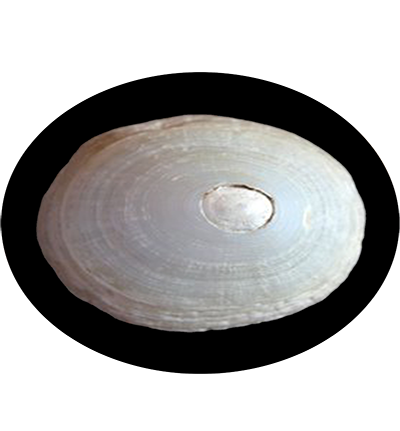
The deep-sea limpet Bathyacmaea lactea is a species in the family Acmaeidae. And it is a common species associated with the dominant mussel beds in cold seeps. They can feed on bacteria and decomposing the periostracum of Bathymodiolus shells, which make deep-sea limpets different from the well-studied symbionts.
Animalia (Kingdom); Mollusca (Phylum); Gastropoda (Class); Patellogastropoda (Subclass); Lottioidea (Superfamily); Pectinodontidae (Family); Bathyacmaea (Genus); Bathyacmaea lactea (Species)
Bathyacmaea lactea S.-Q. Zhang, J.-L. Zhang & S.-P. Zhang, 2016
1. Zhang S, Zhang J, Zhang S. A new species of Bathyacmaea (Gastropoda: Pectinodontidae) from a methane seep area in the South China Sea[J]. Nautilus, 2016, 130(1): 1-4. (Zhang et al., 2016)
Shell whitish, longitudinally elongated. Shell surface with relatively smooth sculpture consisting of dense growth lines and microscopic radial threads. Apertural margin strongly chipped, forming denticle-like structure. Radular formula 0-1-0-1-0. Lateral teeth trifurcated, with straight, stout shaft. All three cusps out¬ wardly bent; innermost and middle cups sickle-shaped and subequal in size, outermost one smallest, with acute tip
Latin lactea, meaning milky white, a reference to die shell color of the new species
A methane seep area at 22°07' N, 119° 18' E, in 1132.5 m depth. South China Sea
| Species | Phylum | Common Name | Ecosystem | Depth | Habitat | NCBI Taxonomy ID |
|---|---|---|---|---|---|---|
| Bathyacmaea lactea | Mollusca | deep-sea limpet Bathyacmaea lactea | Cold seep | 1,388 | Haima cold seeps in the South China Sea | 2049241 |
| Genome Assembly | Genome Size | Assembly level | Released year | WGS accession | Submitter | BioProject | BUSCO completeness (%) | Scaffold/Contig N50 (kb) | GC content (%) | Repeat Rate (%) | Gene Number |
|---|---|---|---|---|---|---|---|---|---|---|---|
| - | 754.3Mb | Contig | 2020 | - | Hong Kong University of Science and Technology | PRJNA588374 | 94.30 | 1570 | 32.67 | 61.4 | 23,574 |
| Title | Journal | Pubmed ID |
|---|---|---|
| De Novo Genome Assembly of Limpet Bathyacmaea lactea (Gastropoda: Pectinodontidae): The First Reference Genome of a Deep-Sea Gastropod Endemic to Cold Seeps | Genome Biol Evol | 32467969 |
| Gene ID | Description |
|---|---|
| MBSQW58_g1 | - |
| MBSQW58_g10 | MONOCARBOXYLATE TRANSPORTER |
| MBSQW58_g100 | GLUCOSE-6-PHOSPHATASE |
| MBSQW58_g1000 | NUCLEAR HORMONE RECEPTOR |
| MBSQW58_g10000 | - |
| MBSQW58_g10001 | PIGGYBAC TRANSPOSABLE ELEMENT-DERIVED PROTEIN 4 |
| MBSQW58_g10002 | EPM2A-INTERACTING PROTEIN 1 |
| MBSQW58_g10003 | PIGGYBAC TRANSPOSABLE ELEMENT-DERIVED PROTEIN 4 |
| MBSQW58_g10004 | - |
| MBSQW58_g10005 | EPM2A-INTERACTING PROTEIN 1 |
| MBSQW58_g10006 | EPM2A-INTERACTING PROTEIN 1 |
| MBSQW58_g10007 | UNCHARACTERIZED |
| MBSQW58_g10008 | - |
| MBSQW58_g10009 | RAS-ASSOCIATING DOMAIN-CONTAINING PROTEIN |
| MBSQW58_g1001 | HISTIDINE-RICH GLYCOPROTEIN |
| MBSQW58_g10010 | - |
| MBSQW58_g10011 | - |
| MBSQW58_g10012 | EUKARYOTIC TRANSLATION INITIATION FACTOR 3 -RELATED |
| MBSQW58_g10013 | UNCHARACTERIZED |
| MBSQW58_g10014 | TUBULIN |
| Annotation ID | Description | Type | Subtype | GeneRatio | Evolution Type | P-value | Q-value |
|---|---|---|---|---|---|---|---|
| GO:0046914 | transition metal ion binding | GO | Molecular Function | - | expanded | - | 2.26E-47 |
| GO:0097159 | organic cyclic compound binding | GO | Molecular Function | - | rapid evolution | 5.49E-232 | 7.19E-230 |
| GO:0097159 | organic cyclic compound binding | GO | Molecular Function | - | expanded | - | 3.96E-39 |
| GO:1901363 | heterocyclic compound binding | GO | Molecular Function | - | rapid evolution | 5.49E-232 | 7.19E-230 |
| GO:1901363 | heterocyclic compound binding | GO | Molecular Function | - | expanded | - | 3.96E-39 |
| GO:0008417 | fucosyltransferase activity | GO | Molecular Function | - | expanded | - | 2.15E-37 |
| GO:0005488 | binding | GO | Molecular Function | - | rapid evolution | 3.80E-82 | 4.41E-80 |
| GO:0005488 | binding | GO | Molecular Function | - | expanded | - | 2.44E-34 |
| GO:0004518 | nuclease activity | GO | Molecular Function | - | expanded | - | 2.02E-31 |
| GO:0008152 | metabolic process | GO | Biological Process | - | expanded | - | 1.22E-30 |
| GO:0010941 | regulation of cell death | GO | Biological Process | - | expanded | - | 2.73E-30 |
| GO:0042981 | regulation of apoptotic process | GO | Biological Process | - | expanded | - | 2.73E-30 |
| GO:0043067 | regulation of programmed cell death | GO | Biological Process | - | expanded | - | 2.73E-30 |
| GO:0016893 | endonuclease activity, active with either ribo- or deoxyribonucleic acids and producing 5'-phosphomonoesters | GO | Molecular Function | - | expanded | - | 4.42E-29 |
| GO:0004523 | RNA-DNA hybrid ribonuclease activity | GO | Molecular Function | - | expanded | - | 4.89E-25 |
| GO:0016891 | endoribonuclease activity, producing 5'-phosphomonoesters | GO | Molecular Function | - | expanded | - | 6.21E-23 |
| GO:0004519 | endonuclease activity | GO | Molecular Function | - | expanded | - | 9.47E-23 |
| GO:0009987 | cellular process | GO | Biological Process | - | expanded | - | 1.99E-21 |
| GO:0004521 | endoribonuclease activity | GO | Molecular Function | - | expanded | - | 2.67E-20 |
| GO:0006486 | protein glycosylation | GO | Biological Process | - | expanded | - | 1.08E-18 |
| GO:0043413 | macromolecule glycosylation | GO | Biological Process | - | expanded | - | 1.08E-18 |
| GO:0070085 | glycosylation | GO | Biological Process | - | expanded | - | 1.08E-18 |
| GO:0003824 | catalytic activity | GO | Molecular Function | - | expanded | - | 8.02E-18 |

